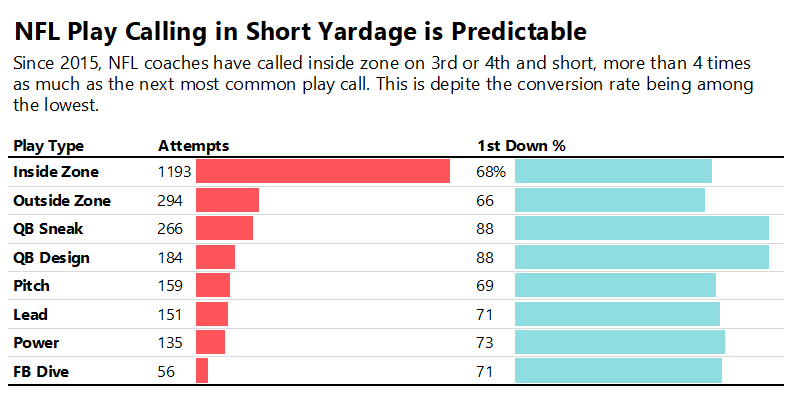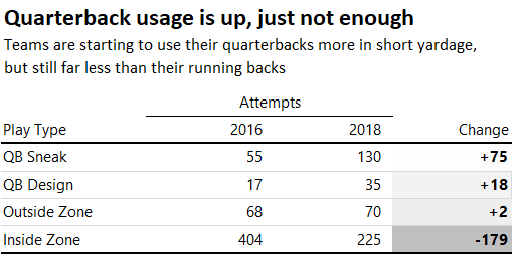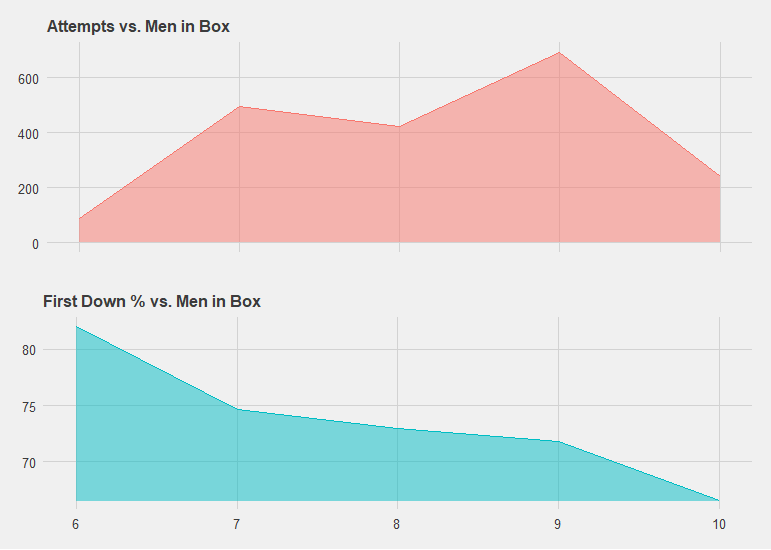It doesn’t get any simpler than the QB sneak. The offensive line drives straight ahead, the quarterback hides himself behind the center and attempts to fall forward a few feet. It’s far from elegant, but it’s effective. And yet, NFL teams seem unwilling to utilize it.
On third or fourth down with a yard or less to go since 2015, teams have called an inside zone (a run up the middle with no pulling lineman or lead blockers) 1,193 times. It’s outside counterpart is a distant second with only 294 attempts. QB sneak ranks third with 266.

Despite being the most commonly run, the inside zone ranks as the second worst play call in terms of first down conversion rate at 68 percent, narrowly edging out the outside zone at 66 percent. By comparison, the QB sneak has a conversion rate of about 88 percent, 20 percentage points better than the inside zone, and 15 percentage points better than the closest play call to a running back.
In theory, based on these numbers, if a team in third- and-1 ran two consecutive quarterback sneaks, they would have approximately a 98 percent chance of converting a first down. This is obviously an imperfect approach, and doesn’t factor in defensive adjustments, but it does help illustrate how baffling it is that teams continue to take the ball out of their QBs hands in these situations.
What’s more, the QB sneak is not an acquired skill, and doesn’t require a particularly athletic quarterback. Since 2015, Blake Bortles, Nick Foles, Drew Brees, and Josh Allen have all boasted perfect conversion rates (Brees has the most successes, 23-of-23). Carson Wentz, Kirk Cousins and Matt Ryan have each failed only once, and no quarterback had a conversion rate lower than the inside zone’s 68 percent.
Increased volume would undoubtedly lead to a decreased success rate, and the list of quarterbacks with a 100 percent conversion rate would likely disappear, but it’s hard to imagine it dropping by 20 percent as a whole.

In the defense of teams, the QB sneak has seen a steady increase since 2016, while the inside zone has rightfully seen a sharp decrease. Even still, the inside zone remained the most common play call in short yardage in 2018, outpacing the QB sneak by almost 100 attempts.
The increase in volume showed almost no effect on the performance of the QB sneak. Its success rate in 2018 of 87 percent was only 1 percentage point lower than its 4-year mark. Likewise, the inside zone did not become more effective with it’s decrease in volume, its 68 percent success rate matched its 4-year total. If there is a point where increased volume decreases the effectiveness of the QB sneak, teams certainly haven’t found it yet.
In terms of personnel, teams have also shown a strong tendency towards heavy personnel when it comes to short yardage. To see the effects this has had, we looked at first down conversion rates against the number of players the offense has “in the box”. Men in the box on the offensive side is just a count of how many men are on or near the line of scrimmage, excluding the quarterback.

In similar fashion to the play types, the most effective personnel grouping is also the most infrequently used. The 6-man box, (most commonly a 4-wide set), had a first down conversion rate of 82 percent but was only used 89 times. The 9-man box, most frequently used by coaches at 692, had a conversion rate of only 71 percent.
Intuitively, having more blockers sounds like a good idea, but in practice it just allows the defense to stack the box and bring in heavier personnel, making the job of the lineman that much more difficult. Using spread-type personnel forces the defense to defend the whole field, and also likely forces them to bring in their smaller dime or nickel personnel, and creates better matchups on the interior.
At least until defenses adjust, teams need to start using their quarterback as a weapon more often in crucial short yardage situations, and stop insisting on heavy personnel. Offense as a whole has become more efficient than ever, and it’s time that expands into short-yardage downs as well.

